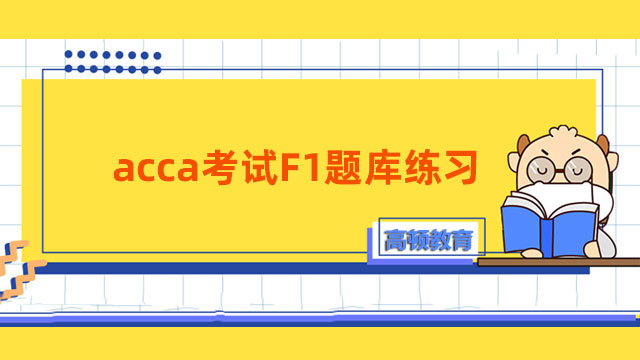ACCA考试P1-P3模拟题及解析17
来源:
高顿网校
2014-07-21
以下是高顿网校小编为学员整理的:ACCA P1-P3模拟题及解析。
Ethan, a public limited company, develops, operates and sells investment properties.
(a) Ethan focuses mainly on acquiring properties where it foresees growth potential, through rental income as well as value appreciation. The acquisition of an investment property is usually realised through the acquisition of the entity, which holds the property.
In Ethan’s consolidated financial statements, investment properties acquired through business combinations are recognised at fair value, using a discounted cash flow model as approximation to fair value. There is currently an active market for this type of property. The difference between the fair value of the investment property as determined under the accounting policy, and the value of the investment property for tax purposes results in a deferred tax liability.
Goodwill arising on business combinations is determined using the measurement principles for the investment properties as outlined above. Goodwill is only considered impaired if and when the deferred tax liability is reduced below the amount at which it was first recognised. This reduction can be caused both by a reduction in the value of the real estate or a change in local tax regulations. As long as the deferred tax liability is equal to, or larger than, the prior year, no impairment is charged to goodwill. Ethan explained its accounting treatment by confirming that almost all of its goodwill is due to the deferred tax liability and that it is normal in the industry to account for goodwill in this way.
Since 2008, Ethan has incurred substantial annual losses except for the year ended 31 May 2011, when it made a small profit before tax. In year ended 31 May 2011, most of the profit consisted of income recognised on revaluation of investment properties. Ethan had announced early in its financial year ended 31 May 2012 that it anticipated substantial growth and profit. Later in the year, however, Ethan announced that the expected profit would not be achieved and that, instead, a substantial loss would be incurred. Ethan had a history of reporting considerable negative variances from its budgeted results. Ethan’s recognised deferred tax assets have been increasing year-on-year despite the deferred tax liabilities recognised on business combinations. Ethan’s deferred tax assets consist primarily of unused tax losses that can be carried forward which are unlikely to be offset against anticipated future taxable profits. (11 marks)
(b) Ethan wishes to apply the fair value option rules of HKFRS 9 Financial Instruments to debt issued to finance its investment properties. Ethan’s argument for applying the fair value option is based upon the fact that the recognition of gains and losses on its investment properties and the related debt would otherwise be inconsistent.
Ethan argued that there is a specific financial correlation between the factors, such as interest rates, that form the basis for determining the fair value of both Ethan’s investment properties and the related debt. (7 marks)
(c) Ethan has an operating subsidiary, which has in issue A and B shares, both of which have voting rights. Ethan holds 70% of the A and B shares and the remainder are held by shareholders external to the group. The subsidiary is obliged to pay an annual dividend of 5% on the B shares. The dividend payment is cumulative even if the subsidiary does not have sufficient legally distributable profit at the time the payment is due.
In Ethan’s consolidated statement of financial position, the B shares of the subsidiary were accounted for in the same way as equity instruments would be, with the B shares owned by external parties reported as a non-controlling interest. (5 marks)
Required:
Discuss how the above transactions and events should be recorded in the consolidated financial statements of Ethan.
Note: The mark allocation is shown against each of the three transactions above.
Professional marks will be awarded in question 3 for the quality of the discussion. (2 marks)
(25 marks)
Amsewer:
(a) The fair value model in HKAS 40 Investment Property defines fair value as the amount for which an asset could be exchanged between knowledgeable, willing parties in an arm’s length transaction. Fair value should reflect market conditions at the date of the statement of financial position. The standard gives a considerable amount of guidance on determining fair value; in particular, that the best evidence of fair value is given by current prices on an active market for similar property in the same location and condition and subject to similar lease and other constraints. Therefore investment properties are not being valued in accordance with the best possible method. This means that goodwill recognised on the acquisition of an investment property through a business combination of real estate investment companies is different as compared to what it should be under HKFRS 3 Business Combination valuation principles. In reality, the fair value of both the property and the deferred tax liability are reflected in the purchase price of the business combination. The difference between this purchase price and the net assets recognised according to HKFRS 3, upon which deferred tax is based, is recognised as goodwill in the consolidated statement of financial position.
Ethan’s methods for determining whether goodwill is impaired, and the amount it is impaired by, are not in accordance with HKAS 36 Impairment of Assets. The standard requires assets (or cash generating units (CGU) if not possible to conduct the review on an asset by asset basis) to be stated at the lower of carrying amount and recoverable amount. The recoverable amount is the higher of fair value less costs to sell and value in use. Fair value less costs to sell is a post-tax valuation taking account of deferred taxes. According to HKAS 36, the deferred tax liability should be included in calculating the carrying amount of the CGU, since the transaction price also includes the effect of the deferred tax and the purchaser assumes the tax risk. Therefore, the impairment testing of goodwill should be based on recoverable amount, rather than on the relationship between the goodwill and the deferred tax liability as assessed by Ethan.
Ethan should disclose both the methodology by which the recoverable amount of the CGU, and therefore goodwill, is determined and the assumptions underlying that methodology under the requirements of HKAS 36. The standard requires Ethan to state the basis on which recoverable amount has been determined and to disclose the key assumptions on which it is based.
In accordance with HKAS 36, where impairment testing takes place, goodwill is allocated to each individual real estate investment identified as a cash-generating unit (CGU). Periodically, but at least annually, the recoverable amount of the CGU is compared with its carrying amount. If this comparison results in the carrying amount being greater than the recoverable amount, the impairment is first allocated to the goodwill. Any further difference is subsequently allocated against the value of the investment property.
The recognition of deferred tax assets on losses carried forward is not in accordance with HKAS 12 Income Taxes. Ethan is not able to provide convincing evidence to ensure that Ethan would be able to generate sufficient taxable profits against which the unused tax losses could be offset. Historically, Ethan’s activities have generated either significant losses or very minimal profits; they have never produced large pre-tax profits. Therefore, in accordance with HKAS 12, there is a need to produce convincing evidence from Ethan that it would be able to generate future taxable profits equivalent to the value of the deferred tax asset recognised.
Any decision would be based mainly on the following:
– history of Ethan’s pre-tax profits;
– previously published budget expectations and realised results in the past;
– Ethan’s expectations for the next few years; and
– announcements of new contracts.
There have been substantial negative variances arising between Ethan’s budgeted and realised results. Also, Ethan has announced that it would not achieve the expected profit, but rather would record a substantial loss. Additionally, there is no indication that the losses were not of a type that could clearly be attributed to external events that might not be expected to recur. Thus the deferred tax asset should not be recognised or at the very least reduced.
(b) Normally debt issued to finance Ethan’s investment properties would be accounted for using amortised cost model. However,Ethan may apply the fair value option in HKFRS 9 Finanical Instruments as such application would eliminate or significantly reduce a measurement or recognition inconsistency between the debt liabilities and the investment properties to which they are related. The provision requires there to be a measurement or recognition inconsistency that would otherwise arise from measuring assets or liabilities or recognising the gains and losses on them on different bases. The option is not restricted to financial assets and financial liabilities. The HKICPA concludes that accounting mismatches may occur in a wide variety of circumstances and that financial reporting is best served by providing entities with the opportunity of eliminating such mismatches where that results in more relevant information. Ethan supported the application of the fair value option with the argument that there is a specific financial correlation between the factors that form the basis of the measurement of the fair value of the investment properties and the related debt. Particular importance was placed on the role played by interest rates,although it is acknowledged that the value of investment properties will also depend, to some extent, on rent, location and maintenance and other factors. For some investment properties, however, the value of the properties will be dependent on the movement in interest rates.
Under HKFRS 9, entities with financial liabilities designated as FVTPL recognise changes in the fair value due to changes in the liability’s credit risk directly in other comprehensive income (OCI). There is no subsequent recycling of the amounts in OCI to profit or loss, but accumulated gains or losses may be transferred within equity. The movement in fair value due to other factors would be recognised within profit or loss. However, if presenting the change in fair value attributable to the credit risk of the liability in OCI would create or enlarge an accounting mismatch in profit or loss, all fair value movements are recognised in profit or loss. An entity is required to determine whether an accounting mismatch is created when the financial liability is first recognised, and this determination is not reassessed. The mismatch must arise due to an economic relationship between the financial liability and the associated asset that results in the liability’s credit risk being offset by a change in the fair value of the asset. Financial liabilities that are required to be measured at FVTPL (as distinct from those that the entity has designated at FVTPL), including financial guarantees and loan commitments measured at FVTPL, have all fair value movement recognised in profit or loss. HKFRS 9 retains the flexibility that existed in HKFRS 7 Financial Instruments: Disclosures to determine the amount of fair value change that relates to changes in the credit risk of the liability.
(c) Ethan’s classification of the B shares as equity instruments does not comply with HKAS 32 Financial Instruments:Presentation. HKAS 32 paragraph 11, defines a financial liability to include, amongst others, any liability that includes a contractual obligation to deliver cash or financial assets to another entity. The criteria for classification of a financial instrument as equity rather than liability are provided in HKAS 32 paragraph 16. This states that the instrument is an equity instrument rather than a financial liability if, and only if, the instrument does not include a contractual obligation either to deliver cash or another financial asset to the entity or to exchange financial assets or liabilities with another entity under conditions that are potentially unfavourable to Ethan. HKAS 32 paragraph AG29 explains that when classifying a financial instrument in consolidated financial statements, an entity should consider all the terms and conditions agreed between members of a group and holders of the instrument, in determining whether the group as a whole has an obligation to deliver cash or another financial instrument in respect of the instrument or to settle it in a manner that results in classification as a liability. Therefore,since the operating subsidiary is obliged to pay an annual cumulative dividend on the B shares and does not have discretion over the distribution of such dividend, the shares held by Ethan’s external shareholders should be classified as a financial liability in Ethan’s consolidated financial statements and not non-controlling interest. The shares being held by Ethan will be eliminated on consolidation as intercompany.
高顿网校小编寄语:笔记要便于看,要经常看,这是又一本教材。

扫一扫微信,*9时间获取2014年ACCA考试报名时间和考试时间提醒
高顿网校特别提醒:已经报名2014年ACCA考试的考生可按照复习计划有效进行!另外,高顿网校2014年ACCA考试辅导高清课程已经开通,通过针对性地讲解、训练、答疑、模考,对学习过程进行全程跟踪、分析、指导,可以帮助考生全面提升备考效果。
报考指南:2014年ACCA考试备考指南
免费题库:2014年ACCA考试免费题库
考前冲刺:ACCA备考秘籍
高清网课:ACCA考试网络课程
报考指南:2014年ACCA考试备考指南
免费题库:2014年ACCA考试免费题库
考前冲刺:ACCA备考秘籍
高清网课:ACCA考试网络课程
版权声明:本条内容自发布之日起,有效期为一个月。凡本网站注明“来源高顿教育”或“来源高顿网校”或“来源高顿”的所有作品,均为本网站合法拥有版权的作品,未经本网站授权,任何媒体、网站、个人不得转载、链接、转帖或以其他方式使用。
经本网站合法授权的,应在授权范围内使用,且使用时必须注明“来源高顿教育”或“来源高顿网校”或“来源高顿”,并不得对作品中出现的“高顿”字样进行删减、替换等。违反上述声明者,本网站将依法追究其法律责任。
本网站的部分资料转载自互联网,均尽力标明作者和出处。本网站转载的目的在于传递更多信息,并不意味着赞同其观点或证实其描述,本网站不对其真实性负责。
如您认为本网站刊载作品涉及版权等问题,请与本网站联系(邮箱fawu@gaodun.com,电话:021-31587497),本网站核实确认后会尽快予以处理。
点一下领资料
【整理版】ACCA各科目历年真题
真题高频考点,刷题全靠这份资料
下载合集
acca全科学习思维导图
梳理核心考点,一图看懂全部章节
下载合集
2023年acca考纲解析
覆盖科目重难点,备考按照计划走
下载合集
acca备考 热门问题解答
- acca考试怎么搭配科目?
-
建议优先选择相关联的科目进行搭配报考,这样可以提高备考效率,减轻备考压力,1、F1-F4:为随时机考科目,难度较低,这里可以自行随意选择考试顺序。2、F5-F9:如果你的工作的和财务会计或者审计有关、或者你比较擅长财务和审计的话,推荐先考F7和F8。你可以选择一起考ACCA考试科目F7和F8或者先考F7(8)再考F8(7),这就要取决你一次想考几门。3、P阶段:选修科目中,建议企业首选AFM!第二部分科目进行选择,如果AA和SBR掌握学生更好,可以通过选择AAA,如果SBL掌握的好,可以自己选择APM。
- acca一共几门几年考完?
-
acca一共有15门考试科目,其中有必修科目和选修科目,考生需要考完13门科目才能拿下证书。
- acca一年考几次?
-
acca一年有4次考试,分别是3月、6月、9月和12月,分季机考科目是采取的这类四个考季的模式,而随时机考则是没有这方面的时间规定限制,可以随报随考。
- acca的含金量如何?
-
ACCA证书的含金量是比较高的,从就业、能力提升、全球认可等角度来说,都是比较有优势的证书,其含金量主要表现在以下几个方面:1、国际化,认可度高;2、岗位多,就业前景好;3、缺口大,人才激励。
严选名师 全流程服务
其他人还搜了
热门推荐
-
acca考试F1题库练习,考生必备! 2023-03-20
-
acca2022真题下载流程介绍,必做考前模考题! 2023-02-24
-
ACCA试卷出题形式?ACCA考试最快多久能通过? 2021-07-24
-
ACCA官方样题 F4(ENG) F8 2021-01-07
-
ACCA考试P1-P3模拟题及解析9 2021-01-07
-
四大会计事务所2017年终精华会评(中) 2018-02-01
-
2016年ACCA F1模拟练习题及答案 2016-02-29
-
2016年ACCA F8每日一练:Professional ethics 2016-01-26
-
2016ACCA考试F8自测题:Corporate governance 2016-01-26
-
关于ACCA考试P7中的专业和道德问题 2015-11-24
-
ACCA P5精选模拟题之战略性绩效考核 2015-10-10
-
ACCA F9模拟测试题之投资评估 2015-10-10
-
ACCA P3精选练习题之战略管理和组织变革 2015-10-10
-
2014年ACCA《公司法与商法》真题及答案七 2015-07-20
-
2014年ACCA《公司法与商法》真题及答案七 2015-07-20
-
2014年ACCA《公司法与商法》真题及答案六 2015-07-20
-
2014年ACCA《公司法与商法》真题及答案五 2015-07-20
-
2014年ACCA《公司法与商法》真题及答案四 2015-07-20
-
2014年ACCA《公司法与商法》真题及答案三 2015-07-20
-
2014年ACCA《公司法与商法》真题及答案二 2015-07-20
-
2014年ACCA《公司法与商法》真题及答案一 2015-07-20
-
2014年ACCA《公司法与商法》真题及答案八 2015-07-20
-
2015年ACCA考试模拟题 2015-06-26
-
2015年ACCA考试精选测试题汇总 2015-06-19
-
2015年ACCA考试《财务成本管理》模拟题汇总 2015-06-18
-
2015年ACCA考试F8模拟试题:Financial Management 2015-06-18
-
ACCA考试2015年《财务成本管理》模拟练习汇总 2015-04-27
-
ACCA考试2015年《财务成本管理》模拟练习5 2015-04-27
-
ACCA考试2015年《财务成本管理》模拟练习4 2015-04-27
 更多服务
更多服务

















